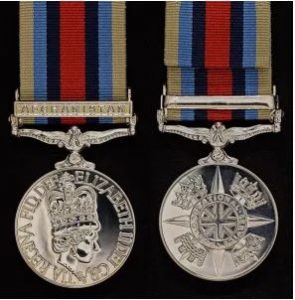Afghanistan – Op HERRICK
Armoured Support Group Royal Marines (ASGRM)
In the summer of 2008, The Queen’s Royal Hussars had been ordered to provide an enlarged troop to supplement the Armoured Support Group Royal Marines (ASGRM) in Afghanistan. Some familiarization with the all-terrain vehicle known as Viking then followed. The training moved from Bovington to Yeovilton to integrate with the Royal Marines and to form a squadron-sized unit.
Deployment took place in early December, and almost immediately the ASGRM began clearing out the Taliban fighters from the area west of Lashkar Gar, the capital of Helmand province. Having cleared the ground, a series of patrol bases were to be built at key junctions to influence the neighbouring population. Routes to these were a magnet for IEDs and, together with constant enemy small-arms fire, roadside bombs were encountered on a daily basis.
In June 2009 as the ASGRM prepared to leave the theatre of operations it was at manning level 20 per cent below that when it deployed – a significant number had been lost to enemy activity. Two young lance corporals of the regiment had been wounded.
Op HERRICK 15
From September 2011 to March 2012 The Queen’s Royal Hussars deployed to Afghanistan (Op HERRICK 15).
The deployment to Afghanistan where, as a battlegroup, the regiment was to form Combined Force Lashkar Gah (LSK), they became the first armoured regiment to undertake this role in doing so. Lashkar Gar is the capital of Helmand, the largest province in the country, and also the world’s largest opium-producing region. Helmand province, long a stronghold of the Taliban, was the British army’s operational area and here had been constructed Camp Bastion, an 8-square-mile base which at its peak housed 40,000 personnel.
The regimental battle group was to deploy as Combined Force (CF) Lashkar Gah and was to operate principally in the precinct of Babaji.
Within the regiment, in order to deploy in various roles, which included a Kandak (Afghan Army infantry battalion) Advisory and Training Team (KATT), a radical reorganization was required. ‘A’ Squadron went into suspended animation, ‘C’ Squadron became an infantry company (Coriano) and ‘D’ Squadron provided the Warthog Squadron, while the rest of the regiment was to man a number of smaller and sometimes complex sub-units.
The fifteen members of ‘B’ Squadron’s KATT arrived at Camp Bastion in mid-September, joining a number of similar teams which made up the Brigade Advisory Group.
‘C’ (Coriano) Company was deployed to Patal Base (PB) Attal in the Nahri Saraj district. The company’s activities were focused on a road: Route 601, which connected Lashkar Gah to Kandahar to the east. Coriano’s area of operations included thirteen checkpoints manned by the Afghanistan Uniform Police (AUP) and the notoriously Taliban-supporting village of Popalzay. The Company played a major role in a battlegroup operation in November 2011 aimed at pushing the insurgent line of enemy troops away from Route 601 in the area near Popalzay, so to allow greater freedom of movement (fewer IEDs) to local nationals.
‘D’ Squadron, ‘the black pigs’, did not deploy as part of the regimental grouping but joined a brigade reconnaissance force with the Queen’s Dragoon Guards. The squadron’s most frequent operation was cordon and search. During the six-month deployment, the Warthogs operated over the whole of the brigade’s area of operation.
(Please allow a few moments for the slideshow to start)
The Queen’s Royal Hussar’s battlegroup returned to Germany in April and May 2012. There had been a number of life-changing injuries and the regiment had sadly suffered its first fatality on operations since the Korean War; Corporal Jack Stanley of Coriano Company who, while on patrol near Popalzay on 3 February, stood on an IED which injured him so severely that he was to die two months later.
Op HERRICK 20
‘C’ Squadron left for Helmand in June 2014, as part of the last British manoeuvre battlegroup to deploy to Afghanistan.
The Warthog group was tasked with protecting Camp Bastion by interdicting the Taliban in depth. During their three-month tour, the squadron conducted ten operations of up to six days in duration, suffered four IED strikes and was in contact with the enemy on 170 different occasions.
The deployment had been busy, challenging, exciting and, above all, successful. They returned to Germany in October.
Campaign Medal
 The Operational Service Medal (OSM) Afghanistan Medal is awarded to personnel who completed operational service on or in support of, operations in Afghanistan from 11 September 2001.
The Operational Service Medal (OSM) Afghanistan Medal is awarded to personnel who completed operational service on or in support of, operations in Afghanistan from 11 September 2001.
Personnel must have served under the command of the UK Joint Task Force Commander and have had 30 days of continuous service or 45 days of aggregated service.
Medal Clasp:
- AFGHANISTAN











